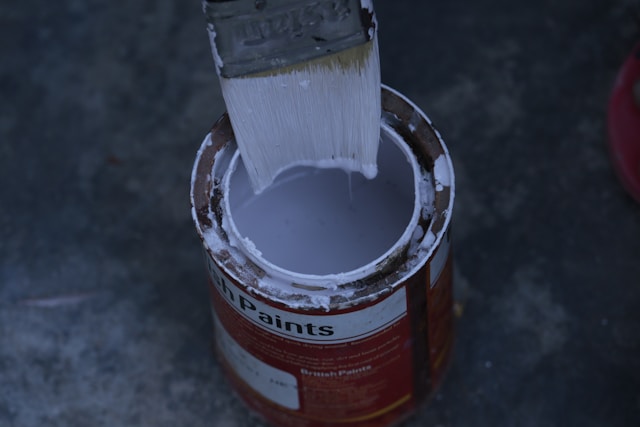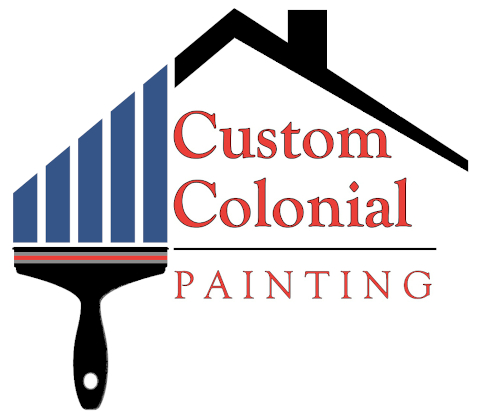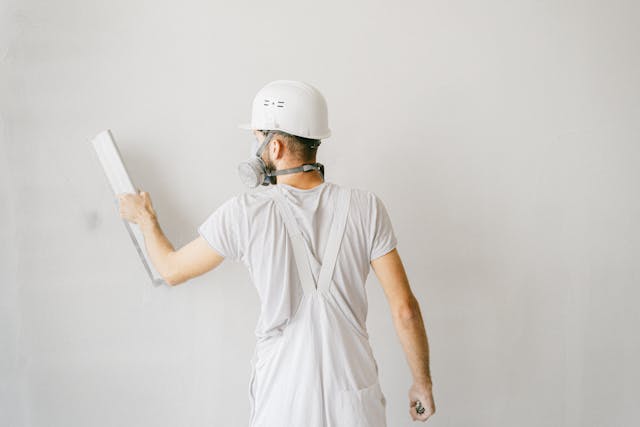Painting molding and trim is one of the most effective ways to elevate the look of any interior. Whether it’s baseboards, crown molding, or window casings, fresh, crisp trim provides clean edges that define a space. But to achieve a flawless result, each step—prep to finish—must be executed properly.
Here’s a comprehensive guide that walks through every phase of painting molding and trim, and when to consider professional trim painting.
Table of Contents
Key Takeaways
✔ Know what kind of trim you’re working with and the material type to choose the right products.
✔ Invest in quality brushes, caulk, primer, and high-quality trim finishes for a professional result.
✔ Clear the space, protect surfaces, and apply painter’s tape before starting.
✔ Remove dust, grease, and loose paint before repairs to ensure proper adhesion.
✔ Fix imperfections, sand the surface, and fill gaps for a flawless base.
✔ Use the right primer based on trim material and prep work to seal and smooth the surface.
✔ Apply thin coats, follow the grain, maintain a wet edge, and use the right brush or sprayer.
✔ Follow dry times, avoid rushing recoats, and inspect for consistent coverage.
✔ Remove tape carefully, fix minor flaws, clean tools, and store leftover paint correctly.
1. Understand the Types of Trim and Molding
Before beginning any painting molding and trim project, it’s important to understand the variety of trim elements found in a home. These architectural details serve both functional and decorative roles and often vary in size, style, and location.
Homes featuring natural materials and sophisticated finishes, such as soapstone countertops and white oak floors, can sell for up to 3.5% more than expected. This shows that even subtle upgrades like well-crafted trim can influence buyer perception and value.These features can be constructed from various materials such as:
- Wood: Durable, easy to sand, and ideal for staining or painting. Requires sealing primer to prevent blotchy finishes.
- MDF (Medium-Density Fiberboard): Cost-effective and smooth, but absorbs moisture, requiring stain-blocking primers and gentle handling.
- Polyurethane or PVC: Lightweight and resistant to warping or cracking. Best used in moisture-prone areas like bathrooms or basements. May need specialized primers for adhesion.
Common types of interior trim and molding include:
Baseboards
Run along the lower edge of interior walls. They protect walls from scuffs caused by shoes, vacuum cleaners, and furniture. Taller baseboards often add a more refined, modern look.
Crown Molding
Installed at the junction of walls and ceilings. This decorative trim adds a touch of elegance and can visually raise the height of a room when installed correctly.
Window and Door Casings
Frame the edges of doors and windows, hiding gaps between the walls and frames. They can be simple or feature layered profiles for a more elaborate appearance.
Chair Rails
Mounted horizontally about one-third up the wall, they protect walls from chair backs and serve as a visual divider between wall colors or treatments.
Wainscoting and Panel Molding
Found on lower wall sections or in formal spaces. These add architectural interest and require detailed work during painting molding and trim to avoid paint pooling in grooves.
2. Gather the Right Tools and Supplies
Having the right tools not only improves efficiency but also affects the overall finish of painting molding and trim. Poor-quality tools can result in streaks, uneven edges, or wasted paint. For projects like this, hiring a professional can get the job done fast and efficiently.
Essential tools and materials include:
- Angled Brushes (2″–2.5″): Designed for cutting in clean lines along edges and corners. Choose high-quality synthetic bristles for latex paint.
- Painter’s Tape: Protects adjacent surfaces and creates crisp lines. Look for delicate surface tape if working over wallpaper or fresh paint.
- Sanding Blocks or Fine-Grit Sandpaper (120–220 grit): Used to smooth out surfaces before priming and between coats for a glass-like finish.
- Wood Filler or Spackling Compound: Fills small holes, nail marks, and dents. Must be sanded smooth after drying.
- Caulking Gun and Paintable Latex Caulk: Seals joints and gaps between trim and walls for a clean, finished look.
- Drop Cloths or Plastic Sheeting: Protects floors and furnishings from paint splatter. Canvas drop cloths offer better grip and reusability.
- Primer (Tailored to Material): Essential for adhesion and even coverage, especially for cabinet and built-in trim painting or surfaces with existing stains or gloss.
- High-Quality Trim Finishes (Semi-Gloss or Gloss): These finishes offer durability and easy cleaning, ideal for frequently touched surfaces like door casings and built-ins.
3. Prepare the Space for Painting
Skipping preparation can ruin an otherwise careful paint job. Taking time to prepare the work area minimizes cleanup and prevents accidental damage. Steps to prep the space:
Move and Protect Furniture
Shift furniture away from the walls and cover it with plastic or cloth sheeting.
Lay Down Drop Cloths
Place drop cloths over floors, carpets, and nearby surfaces to catch spills or drips.
Clean the Trim
Use a microfiber cloth or vacuum with a soft brush attachment to remove dust and cobwebs. Trim near kitchens may require degreasing with a mild soap or TSP solution.
Remove Obstacles
Take off any outlet covers, switch plates, or removable trim pieces to create clear access for painting.
Apply Painter’s Tape
Mask off the following:
- Wall edges where trim meets paint
- Carpet along baseboards (using a putty knife to tuck tape under the trim)
- Window glass, floor edges, or any surface you want to protect
4. Clean and Inspect the Trim Thoroughly
Proper surface prep starts with a clean, contaminant-free surface. Even small amounts of dust, oil, or residue can prevent primer and paint from bonding properly, leading to peeling, flaking, or uneven coverage. Steps to clean and inspect trim effectively:
Wipe with a Damp Cloth
Use warm water with mild soap or a diluted TSP (trisodium phosphate) solution to break down grease, dust, and grime. Especially important in kitchens, bathrooms, or high-touch areas.
Dry Thoroughly
Ensure no moisture is left behind before proceeding. Wet surfaces can trap water under paint layers and cause long-term damage.
Inspect Under Good Lighting
Use a flashlight or portable work light to spot small cracks or gaps, nail holes or screw marks, dents from furniture or foot traffic, and loose molding sections or lifted corners.
Test for Loose Paint
Run a putty knife along the trim’s surface to check for flaking or peeling. Any loose paint must be scraped off before moving forward.
5. Repair, Sand, and Caulk for a Flawless Base
After cleaning and inspection, it’s time to address imperfections. Creating a flawless base ensures that paint adheres uniformly and looks clean and polished when dry. There are certain repairs that DIY methods can’t fix. If you find a few, make sure to contact expert painting contractors to deal with the issue.
Here’s a quick repair and prep checklist:
Fill Imperfections
- Use wood filler or spackling compound to fill nail holes, dents, and gouges.
- Apply with a putty knife, slightly overfilling the area to allow for sanding.
- Let dry fully according to the product instructions.
Sand Surfaces Smooth
- Use fine-grit sandpaper (180–220 grit) to level patched areas and remove glossy finishes.
- Feather the edges of the filler to blend with the surrounding wood.
- Lightly sand the entire trim for better paint adhesion, especially with glossy or pre-painted surfaces.
Vacuum and Wipe Clean
- Remove sanding dust using a vacuum with a brush attachment.
- Follow up with a tack cloth to pick up fine particles.
Caulk Visible Gaps and Seams
- Apply paintable latex caulk where the trim meets the wall or ceiling.
- Smooth the bead using a damp finger, caulk tool, or baby wipe.
- Wipe away excess before it dries.
Check for Shrinkage
Some fillers and caulks shrink as they dry. Reapply if necessary to avoid visible lines under paint.
6. Prime the Surface Properly
Primer is the anchor for any professional trim painting job. It prepares the surface, seals porous materials, blocks stains, and promotes strong paint adhesion. Priming isn’t just a preparatory step—it directly affects the durability and appearance of painting molding and trim, especially on surfaces requiring cabinet and built-in trim painting. Priming is necessary for the following instances:
- Unfinished wood: Raw wood absorbs paint inconsistently and must be sealed first.
- MDF and engineered trim: These materials can swell if painted without proper priming. Use a stain-blocking primer designed for composites.
- Repaired or patched areas: Fillers absorb paint differently from wood. Spot-priming ensures evenness.
- Color transitions: When changing from a dark to a light color (or vice versa), primer prevents show-through.
When priming, here are some best practices to follow:
Choose the Right Primer
- Use a stain-blocking, fast-drying primer for most interior trim and molding.
- Consider shellac-based primers for tough stains or knots in natural wood.
Apply with an Angled Brush
- Work in the direction of the grain.
- Don’t overload the brush—apply thin, even coats to avoid drips.
Allow Proper Drying Time
- Follow the manufacturer’s instructions. In humid conditions, extend drying time.
Lightly Sand After Priming
- Use fine-grit sandpaper to smooth raised grain or brush marks.
- Wipe with a tack cloth before applying paint.
7. Apply Paint with Precision
Applying the topcoat is where all the preparation pays off. Achieving smooth, consistent results while painting molding and trim requires a steady hand, the right tools, and attention to technique. Precision during this step determines how professional the final result looks. Professionals consistently deliver flawless coverage using these methods during professional trim painting jobs.
Best practices for precise application:
Use a High-Quality Angled Sash Brush (2″–2.5″)
Provides control in tight corners and helps maintain crisp lines along edges and grooves.
Choose the Correct Paint Type and Finish
- Use enamel or acrylic-latex paint for trim. These are durable and easy to clean.
- Opt for high-quality trim finishes like semi-gloss or gloss to resist wear and show off architectural details.
Apply Thin, Even Coats
- Thick coats are prone to drips and uneven texture.
- Let each layer dry thoroughly before applying the next to avoid streaking or bubbling.
Paint in the Direction of the Grain
This helps the paint flow smoothly and enhances the natural lines of the trim.
Work Top to Bottom
Start with crown molding, then move to door and window casings, and finish with baseboards to reduce drips and overlap errors.
Maintain a Wet Edge
Keep brushing into freshly painted areas to blend strokes and prevent visible lines.
Use a Paint Sprayer for Ultra-Smooth Finishes
- Mask floors, walls, and adjacent furniture completely.
- Ideal for larger projects or trim with intricate profiles.

8. Allow Adequate Drying and Recoat as Needed
Drying time is often underestimated—but it’s essential to achieving durable, streak-free results when painting molding and trim. Patience during drying ensures that high-quality trim finishes achieve their full durability and gloss level. Drying and recoating tips:
Follow the Manufacturer’s Instructions
- Drying times vary by product and environmental conditions.
- Latex-based paints generally dry to the touch in 1–2 hours but may need 4–6 hours before recoating.
Account for Room Conditions
- High humidity or cool temperatures slow drying.
- Use fans or open windows to improve airflow, but avoid dust while the paint is wet.
Inspect Each Coat Carefully
- Use a bright, angled light to reveal imperfections or thin spots.
- Look for areas where the stain or previous color shows through.
Apply Additional Coats as Needed
- Two coats are typically the standard for interior trim and molding.
- A third coat may be needed when covering dark colors or uneven surfaces.
Avoid Touching or Taping Fresh Paint
- Paint may feel dry, but it isn’t fully cured.
- Curing time can range from 24 hours to several days, depending on the product.
9. Remove Tape and Tidy Up
Finishing strong is just as important as starting right. Proper cleanup and touch-ups leave the trim looking sharp and professional. A polished cleanup and a quick inspection help lock in the success of your painting molding and trim project for years to come. Steps for a clean finish:
Remove Painter’s Tape Carefully
- Do this once the paint is dry to the touch, not completely cured
- Pull the tape slowly at a 45-degree angle to avoid tearing or pulling up paint.
Score Along Tape Edges if Needed
If the paint formed a film over the tape edge, use a utility knife to lightly score before removing to prevent lifting the finish.
Inspect for Touch-ups
- Use a small artist brush to fix minor smudges or missed spots.
- Dab gently rather than brushing to avoid texture inconsistencies.
Clean Tools Thoroughly
- Use warm water and soap for latex paint.
- Clean brushes immediately to preserve bristle quality for future use.
Label and Store Leftover Paint
- Save extra paint for future cabinets and built-in trim painting touch-ups.
- Store in a cool, dry place with the date and color noted on the lid.
Why Hire a Professional Painting Contractor
Hiring a professional painting contractor in Westport, CT, offers more than just convenience—it ensures a polished, long-lasting finish that enhances the beauty of any space. Painting molding and trim demands precision, the right materials, and technical know-how. Professional trim painting specialists bring all of this and more to the table.
1. Achieve Flawless Results
Professional painters are trained to deliver crisp edges, smooth surfaces, and uniform coverage, especially on detailed interior trim and molding. They understand how to avoid common issues like brush marks, paint runs, or uneven sheen.
2. Save Time and Minimize Disruption
A trained crew can complete cabinet and built-in trim painting or whole-home trim work in a fraction of the time it would take a DIYer, without sacrificing quality. This is especially valuable for busy homeowners or tight project schedules.
3. Access the Best Tools and Techniques
Pros use commercial-grade brushes, sprayers, and sanding systems to apply high-quality trim finishes efficiently. They know when to brush, roll, or spray for optimal results based on the type of trim and layout.
4. Use the Right Products for the Job
Professional painters can select the ideal primer and paint combinations for different materials, from MDF to hardwood to polyurethane. They know how to avoid compatibility issues that lead to peeling or chipping.
5. Handle Challenging Spaces with Ease
Complex crown molding, tall baseboards, built-ins, or trim near staircases require ladders, scaffolding, and advanced application skills. Pros are equipped and trained to manage these areas safely and efficiently.
6. Deliver Long-Term Value
A professional paint job extends the lifespan of the trim, reduces maintenance needs, and preserves the overall appearance of your home. Newly remodeled homes consistently attract top-dollar offers, often selling for nearly 4% above their expected market value. Investing in expert work pays off in durability and satisfaction.
Frequently Asked Questions
Should you paint trim or walls first?
It’s usually recommended to paint the trim first before tackling the walls. This makes it easier to cut in clean lines along the edges and allows you to cover any trim paint that gets on the walls. Once the trim is fully dry, you can tape it off and move on to painting the walls.
Do you need to remove the trim before painting it?
Removing trim before painting is not required in most situations. You can achieve clean results by using painter’s tape to protect adjacent walls, floors, and ceilings. Keeping the trim in place saves time and avoids the risk of damaging the wall during removal.
What is the best paint sheen for trim and molding?
Semi-gloss and gloss finishes are the top choices for painting molding and trim. These sheens are durable, easy to wipe clean, and resistant to moisture and scuffs. They also enhance the architectural details by reflecting more light.
Can you paint over stained or varnished trim without sanding?
It’s not advisable to skip sanding when painting over stained or varnished trim. Light sanding helps remove the glossy finish and allows the primer to bond properly. Skipping this step can result in peeling or chipping down the line.
How do you avoid brush marks when painting trim?
To prevent brush marks, use a high-quality angled brush and apply thin, even coats of paint. Keep a wet edge and brush in the direction of the grain for smoother results. Adding a paint conditioner can also improve flow and reduce visible strokes.
Call Custom Colonial Painting Today for Flawless Trim Results!
If you’re ready to refresh your home with clean, professional trim, skip the hassle and call the experts at Custom Colonial Painting. Based in Westport, CT, we specialize in painting molding and trim with precision and care, but our services go far beyond that. From interior and exterior painting to cabinet refinishing, deck staining, and popcorn ceiling removal, we provide comprehensive solutions for homeowners looking to upgrade their space.
For Westport, CT, residents seeking high-quality services, Custom Colonial Painting is the trusted name to call. Contact us today.



